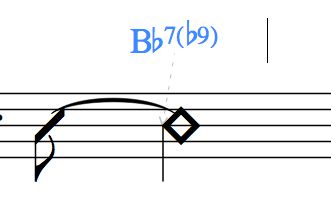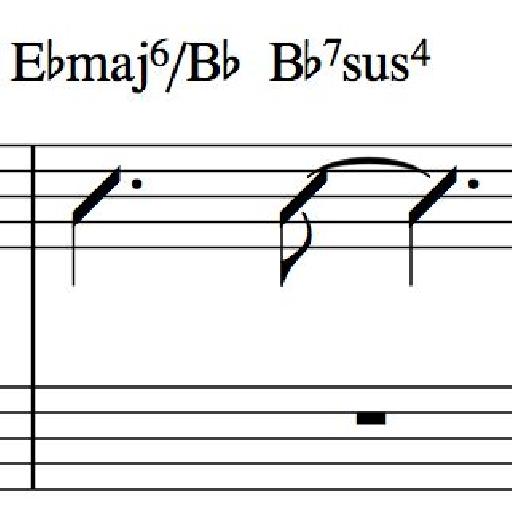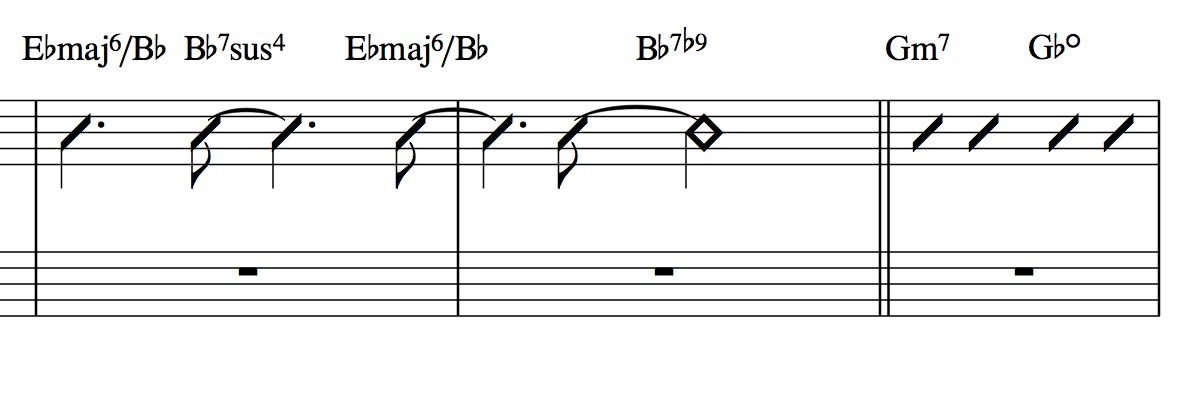February 2, 2011 - the beginning of an immense project for jazz vocalist Nikki Yanofsky, orchestrating an evening's concert of fifteen standards for full orchestra and nine-piece band. My collaborator is jazz pianist and composer Paul Shrofel, who is working with Nikki to set the program, and is doing a lot of preliminary sketches and some very tasty band arrangements. Paul's got some great suggestions and ideas for the orchestration of these standards, like the first song that I got e-mailed last night, I Got a Crush On You. And he's knocking me out with these awesome sub chords...take a look at these bars...
I can do something really colorful with that, contrasting the root harmony against the added notes while emphasizing some of the inner voices, and enhancing the cool overtones in places. So I set to work, thinking how great it is to be orchestrating right off of a chord chart, sort of like faking a lead in really slow motion with 70 pairs of arms each holding a different orchestral instrument. Now fast-forward to July 2012, on the eve of my macProVideo Sibelius 101 Lead Sheet Project release. That tutorial has got me thinking back to Paul's arrangements, and about Sibelius's chord symbol input. I wish that I could have put a lot more information about complex chords into the 101 course, but the timing is not quite right. Until my 103 course comes out, here are a few tips for inputting your own over-the-top chords.
First is the keyboard shortcut. To start a chain of chord symbol input, select your first note, and type Command-K (or Control-K on Windows). That gets you a blinking cursor over the first note.

Now, to input the first of Paul's ultra-badass chords, type “ebmaj6/bb” - then hit the Spacebar, which will advance the cursor to the next beat, leaving you with the elegantly engraved....

Note that “b” can work as a “B” or as a flat: it just depends what position it sits in the text stream. Paul hastily worked out the chords as text input on this score - note how the chord symbol text line interpretation of Sibelius doesn't accept Paul's emphasis on the identity of the chord as “major,” but mercilessly shortcuts it. The 6 miniaturizes, and leaps up into position. Paul's next chord also has changes. If you type “bb7sus4” then you get...

...as you can see, Sibelius 7 has parenthesized the suspension, as per current engraving standards. The next chord is the same as the first, so just retype it or select the first one and paste it over the note. But the fourth chord in the middle of the second bar also gets a parenthetical revamp, which you can see if you type “bb7b9...”

The next chord is just a plain-Jane G minor 7th (“gm7”), but I love the chord that follows: G-flat diminished - that's some deep, dark magic. To get that, you type “gbdim”, which automatically gives you the little diminished circle....

I couldn't very well put sub chords like that into Greensleeves, the example piece for the Sibelius 101 lead sheet, and stay true to the music (not to mention to stay focused on basics). But if you're so hip that you've lost the ability to play four simple triads in a row (and you know who you are), then you have my blessings to take that passamezzo and make it scream, you crazy cats!
Part 2 of this article is here.




 © 2024 Ask.Audio
A NonLinear Educating Company
© 2024 Ask.Audio
A NonLinear Educating Company
Discussion
Want to join the discussion?
Create an account or login to get started!